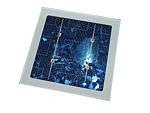Solar-Powered Aircraft Developments Solar One
| Solar One | |
|---|---|
| Role | Electric aircraft |
| National origin | United Kingdom |
| Manufacturer | Solar-Powered Aircraft Developments |
| Designer | David Williams |
| First flight | 19 December 1978 |
| Introduction | 1978 |
| Retired | 1979 |
| Number built | One |
| Program cost | £16,000 |
|
| |
The Solar-Powered Aircraft Developments Solar One is a British mid-wing, experimental, manned solar-powered aircraft that was designed by David Williams and produced by Solar-Powered Aircraft Developments under the direction of Freddie To and first flown on 19 December 1978. It was the third solar-powered aircraft to fly, after the unmanned AstroFlight Sunrise and the manned Mauro Solar Riser.[1][2][3]
Design and development
Freddie To was a member of the Kremer prize committee who started a project to produce a human-powered aircraft to compete for the prize. The resulting aircraft, at 230 lb (104 kg), proved too heavy for human-powered flight and so was converted to solar power instead. A nose-mounted pod powerplant was installed consisting of four 1 hp (1 kW) permanent magnet 36 volt DC, 12 amp Bosch electric motors, powered by 750 solar cells of 3 inch diameter and a 65 lb (29 kg) Nickel-cadmium battery pack of 24 cells with a 25 amp hour capacity, connected in series. The motors are connected by a 3:1 bicycle chain reduction drive to a 63 in (160 cm) wooden two-bladed propeller, which turns at a maximum of 1,100 rpm, decreasing with battery discharge. The engines are controlled with a simple on/off switch. For flight the aircraft used its on-board solar cells to recharge the battery array on the ground and then the batteries provided power for flight as the aircraft had insufficient solar cells for sustained flight. This shortcoming was not a design feature, but a problem of the cost of the solar cells as the limited project budget of £16,000 did not allow the purchase of sufficient cells. The 750 installed solar cells cost £6,000 and were the most expensive part of the aircraft.[1][2][3]
The Solar One is constructed of a wooden structure covered with heat-shrunk Solarfilm model aircraft covering. The wing was built in three sections, a centre section and two outer wing panels to simply storage and transport. The wing spar is a laminated spruce girder box-spar design. The tail surfaces are quickly removable for storage.[1]
The installed batteries provide for a climb of eight minutes plus a two-minute cruise allowance.[1]
Operational history
The aircraft's first flight was a short hop that occurred at Lasham Airfield, Hampshire, United Kingdom on 19 December 1978. Fred To was not present when this occurred, and the pitch of the propeller was found to be incorrectly set, which was why it was a short hop. Subsequent flights occurred in 1979, and those are often mistakenly taken as the first flights of the aircraft,[1] as confirmed by Barry Jacobson (a member of the SolarONE team). The 1979 flight took place on 13 June and covered just under 0.75 mi (1.2 km). The pilot was Ken Stewart and the aircraft lifted off at 18 to 20 kn (33 to 37 km/h) and reached 35 kn (65 km/h) and 80 ft (24 m) in height. A second flight on the same day by Bill Maidment achieved a speed of 42 kn (78 km/h). All flights were made on battery power that had been recharged on the ground from the installed solar cells.[1][2]
An intended flight across the English Channel was abandoned when the aircraft did not reach intended endurance targets.[2]
Specifications (Solar One)
Data from History of Solar Flight[2] and Flight Global[1]
General characteristics
- Crew: one
- Length: 22 ft 0 in (6.71 m)
- Wingspan: 68 ft 0 in (20.73 m)
- Wing area: 260 sq ft (24 m2)
- Aspect ratio: 17.8:1
- Airfoil: Wortman FX180
- Empty weight: 230 lb (104 kg)
- Powerplant: 4 × Bosch permanent magnet motors, 36 volt DC, 12 amps each, with a 3:1 bicycle chain reduction drive, powered by 750 solar cells of 3 inch diameter and a Nicad battery pack of 24 cells of 25 amp hour capacity connected in series, 1 hp (0.75 kW) each
- Propellers: 2-bladed wooden, 5 ft 3 in (1.60 m) diameter
Performance
- Maximum speed: 48 mph; 78 km/h (42 kn)
- Service ceiling: 80 ft (24 m)
See also
- Aircraft of comparable role, configuration and era
References
External links
- Photos of the Solar One (PDF)
